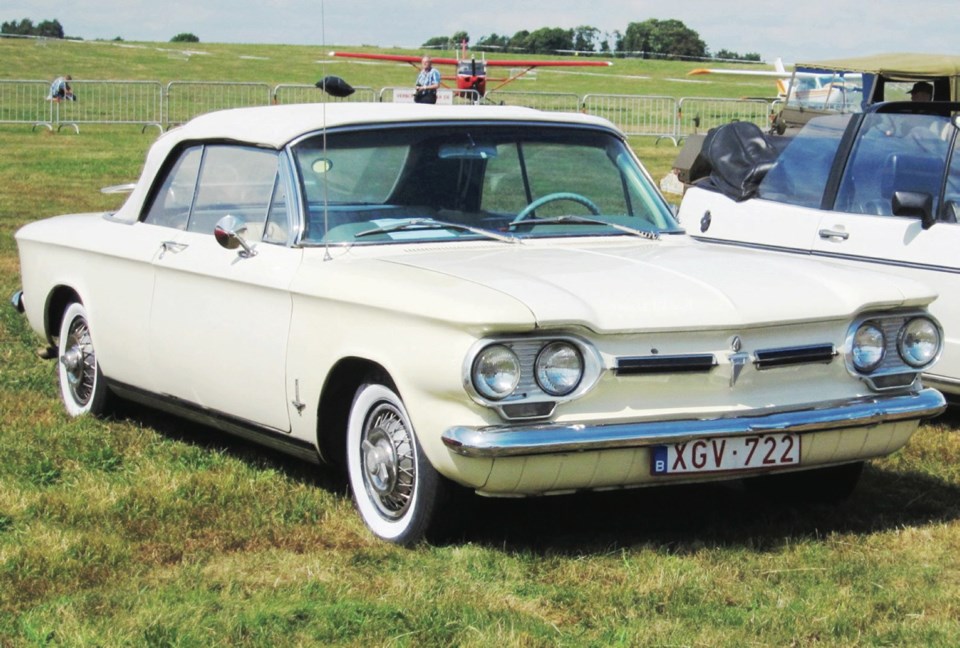The compact Chevrolet Corvair was the most daring and technically interesting car to come out of Detroit in the 1960s. In an industry devoted to large front-engined, rear-drive cars with solid rear axles and cast-iron V-8 engines, Chevrolet’s general manager, Edward Cole, took a bravely different approach with the Corvair.
The Corvair’s engine was an aluminum, horizontally opposed (flat), air-cooled six-cylinder. Even more unusual is that Chevrolet located it behind the rear axle. It had a unit construction body-chassis and four wheel independent coil spring suspension.
With these features, Chevrolet had unabashedly copied the German Volkswagen, the most popular import. But Chevrolet didn’t stop there. Along with Oldsmobile, it would go further than Volkswagen or any other manufacturer and pioneer production-car turbocharging.
A turbocharger is a small gas turbine driven by the engine’s exhaust flow and used to spin an air compressor that packs more air into the cylinders than they would breathe naturally. This produces “free” horsepower from the exhaust stream because more air and fuel in means more horsepower out.
Chevrolet went the turbo route for more power because its configuration precluded fitting larger-displacement engines that could be fitted to conventional rivals Ford Falcon and Chrysler (soon to be Plymouth) Valiant.
Cole was convinced he could build a bigger, better “American Volkswagen.” The Corvair’s 2,743-millimetre wheelbase was 343 mm longer than the VW’s, and the Corvair’s 1,111-kilo weight was 363 kg heavier. While the VW had a small 1.2-litre, 36-horsepower four-cylinder engine, the Corvair’s was a 2.3-litre, 80-horsepower six.
In spite of its technical novelty, or perhaps because of it, the Corvair was outsold by its main rivals Ford Falcon and Chrysler Valiant. But it appealed to the sporty car market, and to exploit this, Chevrolet introduced what it called the Monza version of the Corvair in mid-1960.
The Monza was just a Corvair Deluxe 700 coupe fitted with items such as bucket seats, fancier wheel covers, chrome rocker mouldings and vinyl upholstery. But these minor styling changes were enough to alter the Corvair’s personality and set it apart from mundane workaday Corvairs. Monza sales took off.
Chevrolet then set out to really pursue the sporty-car segment. For 1961, it introduced a four-speed manual transmission, and for 1962 it had even bigger news: the Corvair Monza Spyder in coupe and convertible forms. The Spyder’s most outstanding feature was its exhaust-driven turbocharger.
Chevrolet, therefore, along with Oldsmobile, which had introduced its turbocharged F-85 Jetfire model just a month earlier, made General Motors the world’s first manufacturer to offer automobile turbocharging.
The turbo gave the Spyder a big performance boost over other Corvairs. Car Life magazine tested a four-speed manual transmission Spyder and recorded zero to 100 km/h in 10.8 seconds and top speed of 169 km/h. In comparison, an earlier test of a four-speed, naturally aspirated, 98-horsepower Monza recorded zero to 100 in 15.5 seconds and top speed of 148 km/h.
In 1965, the Corvair underwent a big change, receiving a beautiful all-new longer, lower and wider body. Underneath, it had a significantly improved the rear suspension with Corvette-like fully articulated axles replacing the swing axles. This new rear axle corrected a major engineering criticism of the Corvair.
The Monza was relegated to a mid-pack model and the Corsa became the top-of-the-line Corvair. The turbocharger was now an option on the Corsa and horsepower was now 180, increased from 150 from an engine now up to 2.7 litres.
Along with new styling and better suspension for 1965 came something else: a surprise in the form of a book entitled Unsafe At Any Speed. In Unsafe, a Washington, D.C., consumer advocate and lawyer named Ralph Nader excoriated the auto industry, alleging it was building unsafe cars.
His attack on the Corvair was particularly scathing, saying, among other things, that its swing-axle suspension (as used on the ’60 to ’64 models) allowed the rear wheels to “tuck under” and cause the Corvair to flip over in relatively low-speed cornering.
Nader’s book, plus stiff competition from Ford’s sporty new Mustang introduced in 1964, sent Corvair sales into rapid decline. It would ultimately be discontinued in 1969. The turbocharger option ended in 1966.
Turbos would disappear from automobiles for about a decade, because it was easier and cheaper to get more power by building a bigger engine. In spite of the ultimate failure of the Corvair in the marketplace, Chevrolet and sister GM Division Oldsmobile paved the way for the now very popular turbocharging, even though at that time the market wasn’t quite ready for it.



